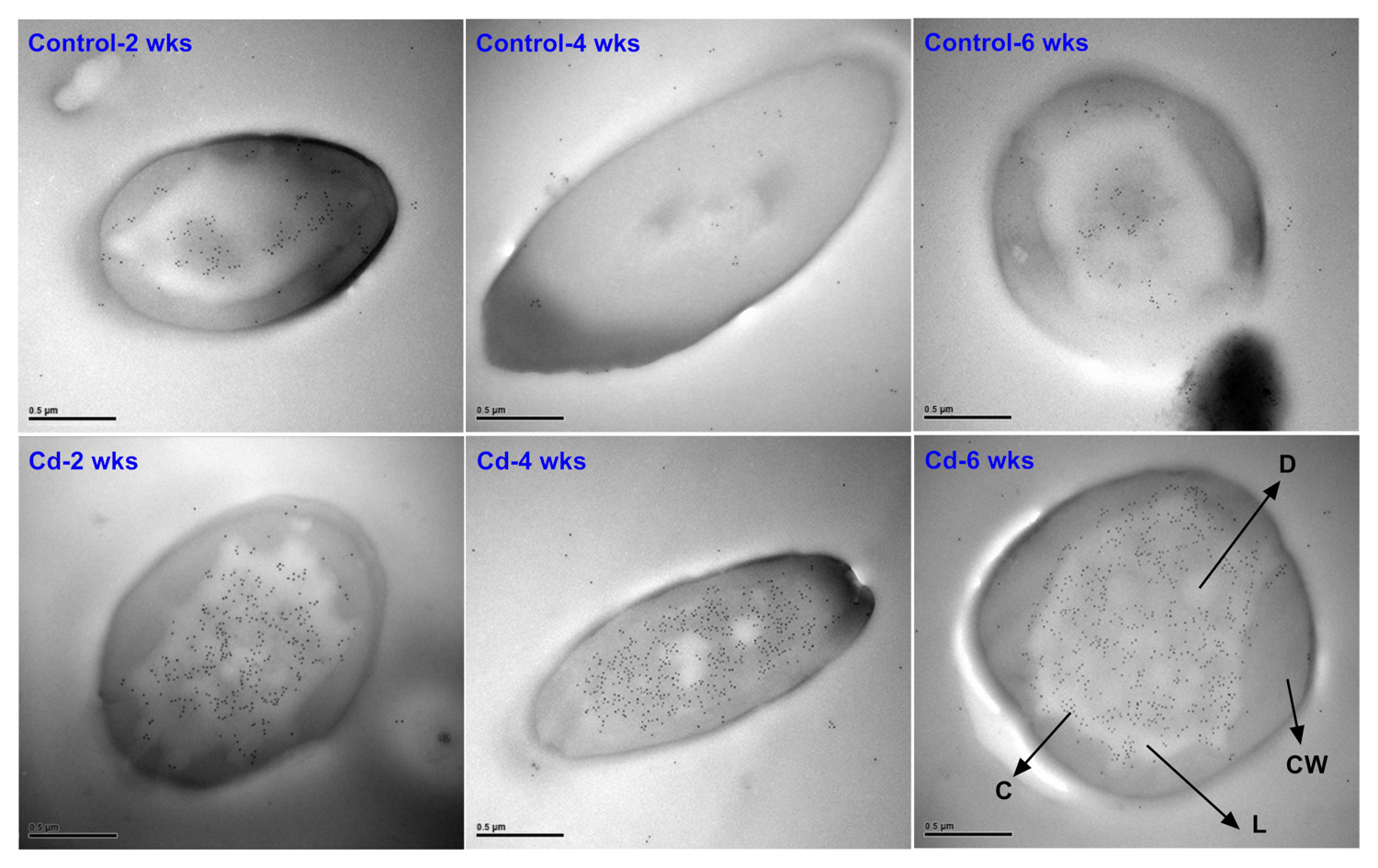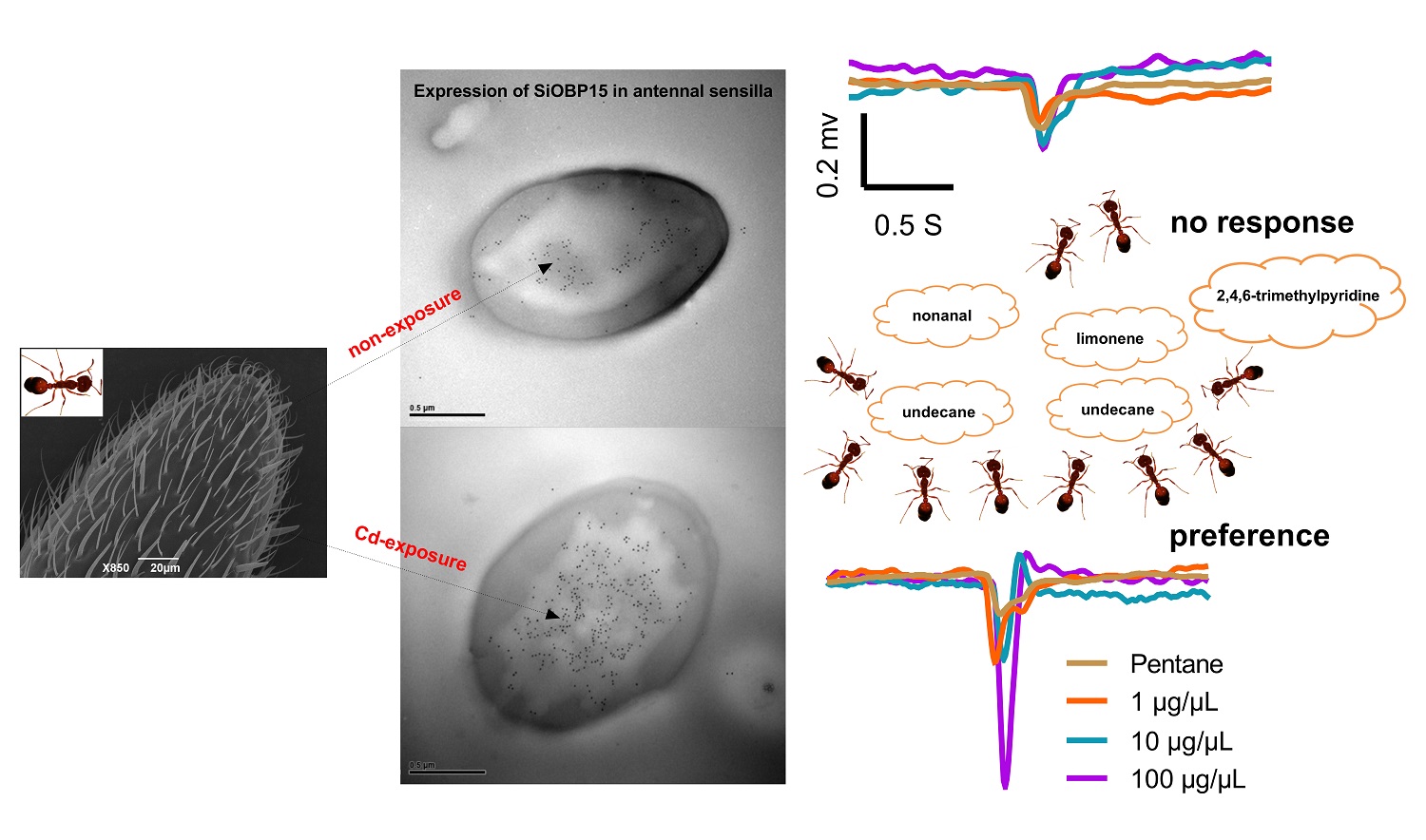南湖新闻网讯(通讯员 杨复香)近日,我校植物科学技术学院王满囷教授带领昆虫化学生态学团队在《Environmental Science & Technology》发表题为“Sublethal Exposure to Cadmium Induces Chemosensory Dysfunction in Fire Ants”的研究论文。该研究阐明了重金属镉(Cd)污染对入侵害虫红火蚁嗅觉识别的影响,揭示了Cd污染诱导红火蚁嗅觉功能紊乱的分子机制。
红火蚁(Solenopsis invicta Buren)是世界自然保护联盟(IUCN)收录的全球100种最具破坏力的入侵物种之一。自2003年在我国台湾省首次发现红火蚁入侵以来,该害虫不断向北扩散蔓延。目前,红火蚁已入侵华南、华东、华中及西南的12个省区,对当地农林业生产、人畜安全和生物多样性造成严重威胁。红火蚁疫情监测是科学防控的基础。基于嗅觉识别的诱饵诱集技术是当前红火蚁种群监测的主要手段。红火蚁是社会性昆虫,蚁群具有土栖、杂食和局域性利用资源等特点,容易因环境污染物的富集干扰其生理过程和社会行为。
Cd被认为是动物的嗅觉毒剂,但Cd影响动物嗅觉功能的分子机制目前尚不清楚。团队前期研究证实,Cd能沿食物链在红火蚁蚁群中富集,Cd暴露改变了红火蚁工蚁气味结合蛋白(SiOBPs)的表达模式,同时干扰了红火蚁对报警信息素及追踪信息素等多种功能信息物质的识别(Yang et al., 2021, Environmental Pollution;Zhou et al., 2022, Journal of Pest Science)。为进一步研究Cd污染影响红火蚁嗅觉识别的分子机制,本研究在前期工作的基础上,发现红火蚁工蚁摄食低剂量Cd即可导致SiOBP7基因表达显著下调,而SiOBP15基因表达显著上调,Western blot和免疫组化结果表明长期摄食Cd能够诱导SiOBP15蛋白在红火蚁工蚁触角感器上调表达。

Cd暴露诱导SiOBP15蛋白在红火蚁工蚁触角感器表达
研究人员进一步分析了SiOBP7和SiOBP15蛋白与22种红火蚁食物源气味分子的结合特性,发现SiOBP7与SiOBP15蛋白与柠檬烯(limonene)、壬醛(nonanal)及2,4,6-三甲基吡啶(2,4,6-trimethylpyridine)均具有较强的结合能力。同时,SiOBP15蛋白与正十一烷(undecane)也具有较强的结合能力。利用上述气味分子进行电生理及行为学验证,发现未经Cd暴露的红火蚁工蚁对柠檬烯、壬醛及2,4,6-三甲基吡啶具有强烈的触角电位及行为反应,而对正十一烷无明显反应。然而,摄食Cd抑制了工蚁对上述3种活性物质的触角电位及行为反应,而诱导了工蚁对正十一烷的电生理及行为反应。进一步干扰SiOBP7和SiOBP15发现,工蚁对壬醛及正十一烷的行为活性显著降低,这些结果表明Cd污染抑制SiOBP7而诱导SiOBP15表达是导致红火蚁工蚁对食物源气味分子行为反应变化的重要原因。研究结果揭示了Cd污染影响红火蚁嗅觉识别的机制,为重金属污染地区红火蚁种群科学监测技术的研制提供了新的思路,同时为揭示红火蚁入侵的生态适应机制奠定了理论基础。

Cd污染改变红火蚁工蚁触角OBPs表达干扰其对气味分子的识别
植物科学技术学院2019级硕士研究生杨复香为论文第一作者,周爱明副教授为论文通讯作者。硕士生张国庆、刘锦龙,博士生段双刚,华中农业大学王满囷教授,华南农业大学陆永跃教授和中国热科院环境与植物保护研究所李磊副研究员参与了该项研究。该研究得到国家自然科学基金、国家重点研发计划和海南省重大科技计划的资助。
审核人:周爱明
【英文摘要】
Ants easily accumulate cadmium (Cd) from the food web in terrestrial ecosystems. Cd contamination may cause olfactory dysfunction and consequently disorders in the social behavior of ants. To explore the molecular mechanism underlying the effect of Cd exposure on the chemosensory process of ants, we characterized the Cd-induced variations in the expression of genes involved in chemoreception and electrophysiological and behavioral sensitivity to semiochemicals by using the red imported fire ant, Solenopsis invicta, as a model system. As a result, Cd exposure increased Cd accumulation and decreased the survival rate of S. invicta. Cd exposure altered the expression profiles of odor binding protein genes of S. invicta (SiOBPs). Specifically, SiOBP15 protein expression was upregulated upon Cd exposure. Both SiOBP7 and SiOBP15 exhibited high binding affinities to limonene, nonanal, and 2,4,6-trimethylpyridine. S. invicta exposed to Cd showed less sensitive electrophysiological and behavioral response to the three chemicals but exhibited sensitive perception to undecane. Silencing of SiOBP7 and SiOBP15 abolished the behavioral response of S. invicta to nonanal and undecane, respectively, suggesting that SiOBP7 and SiOBP15 play essential roles in the chemoreception of S. invicta. In general, our results suggest that Cd contamination may interfere with olfactory signal transduction by altering the expression of SiOBPs, consequently evoking chemosensory dysfunction in fire ants.
